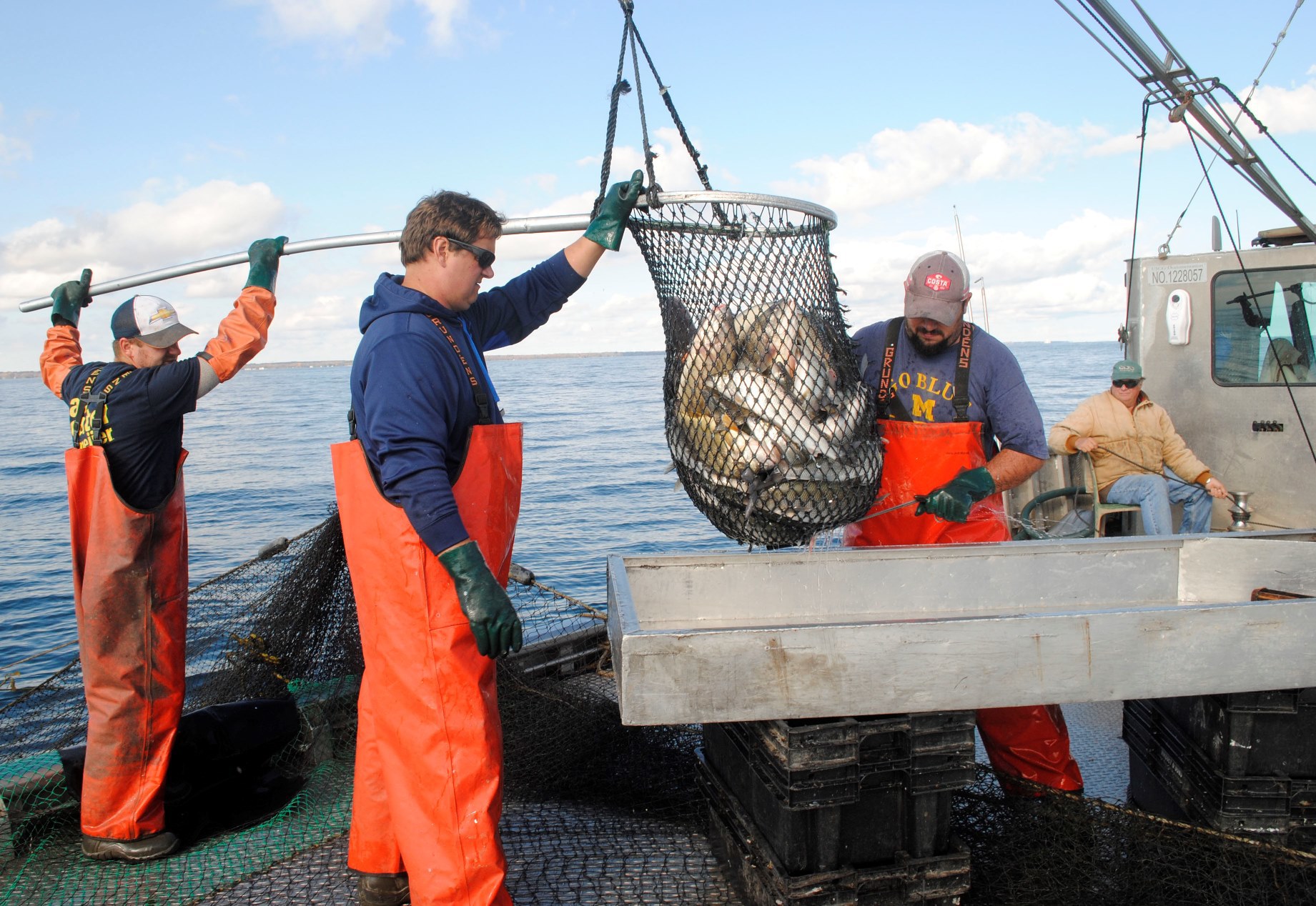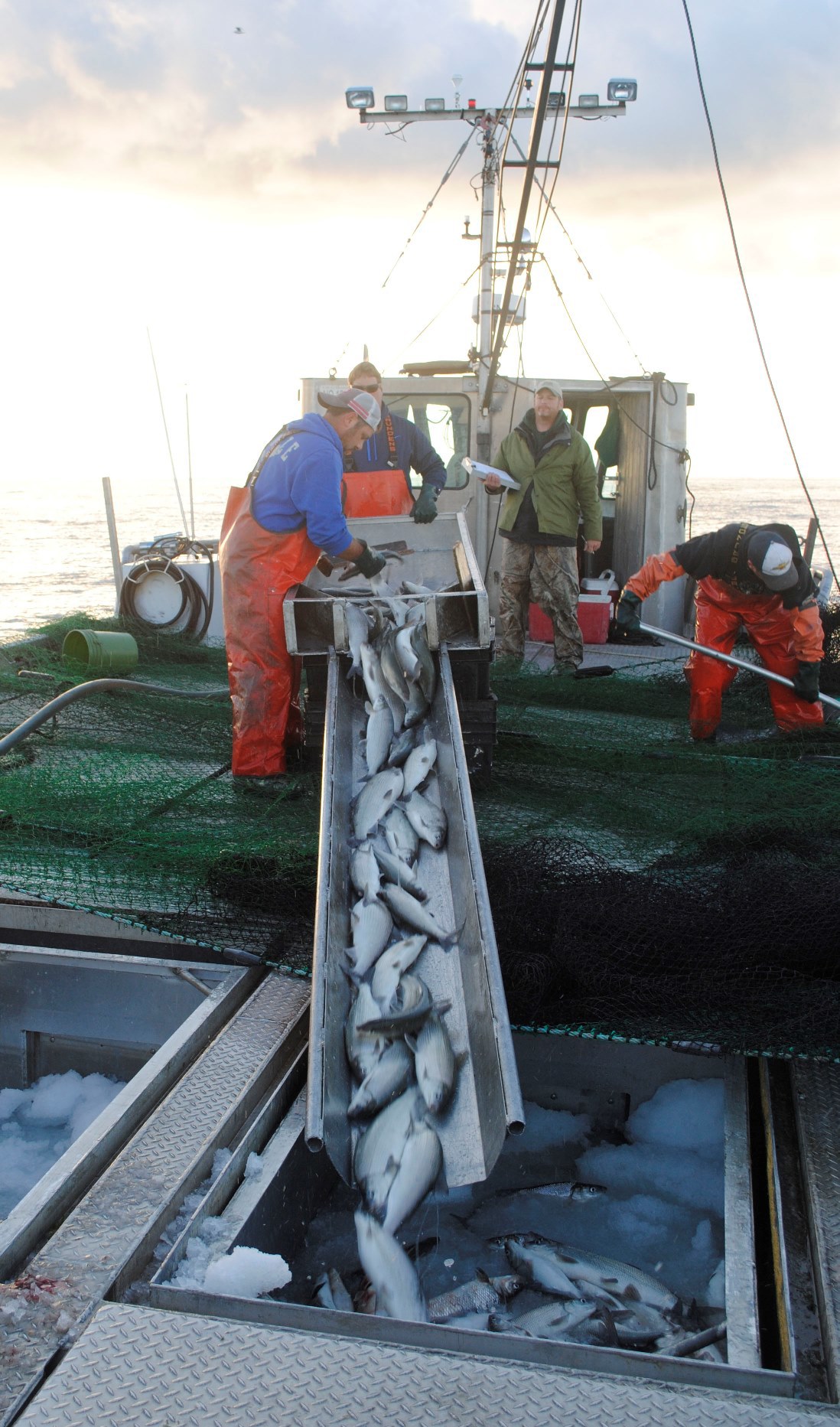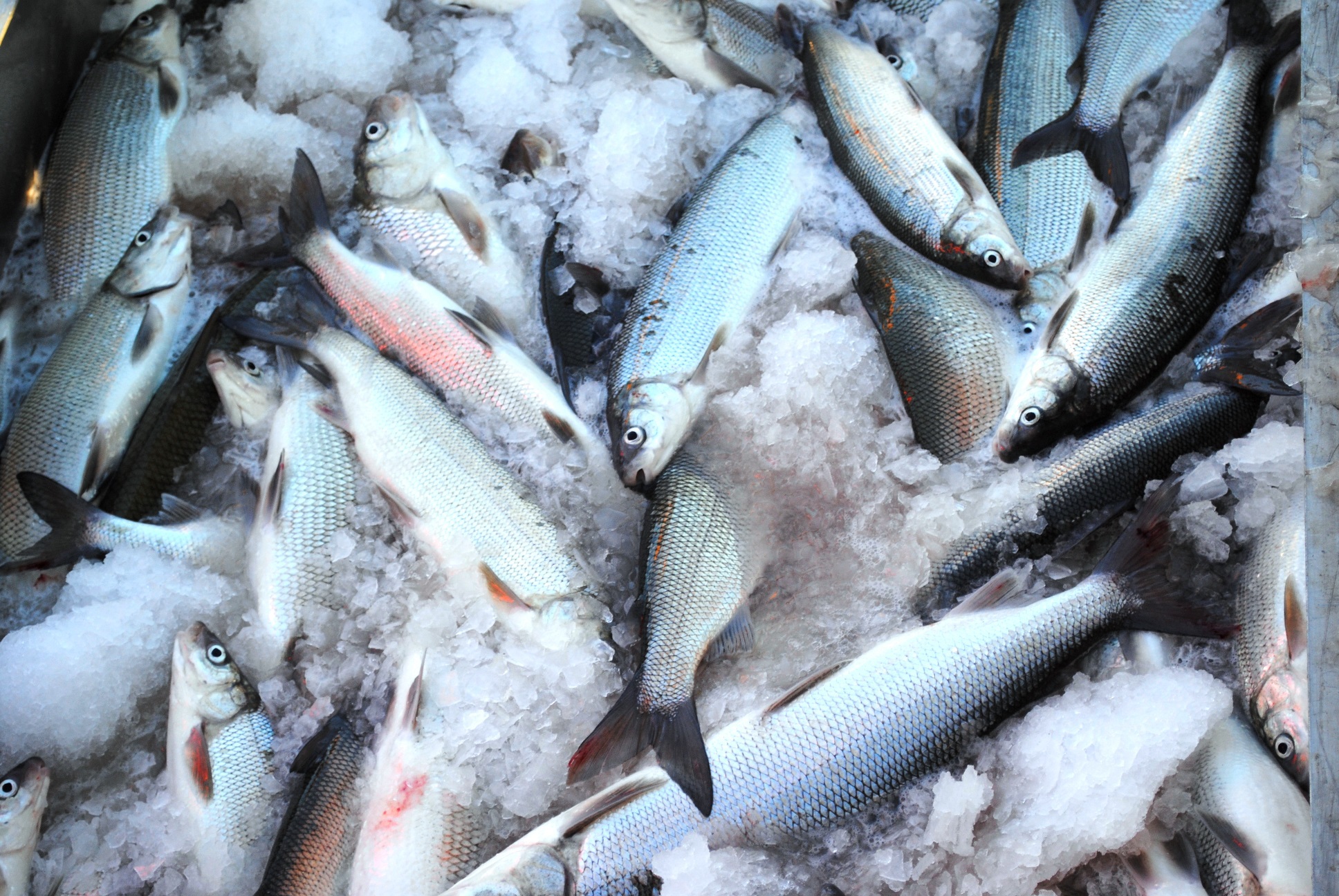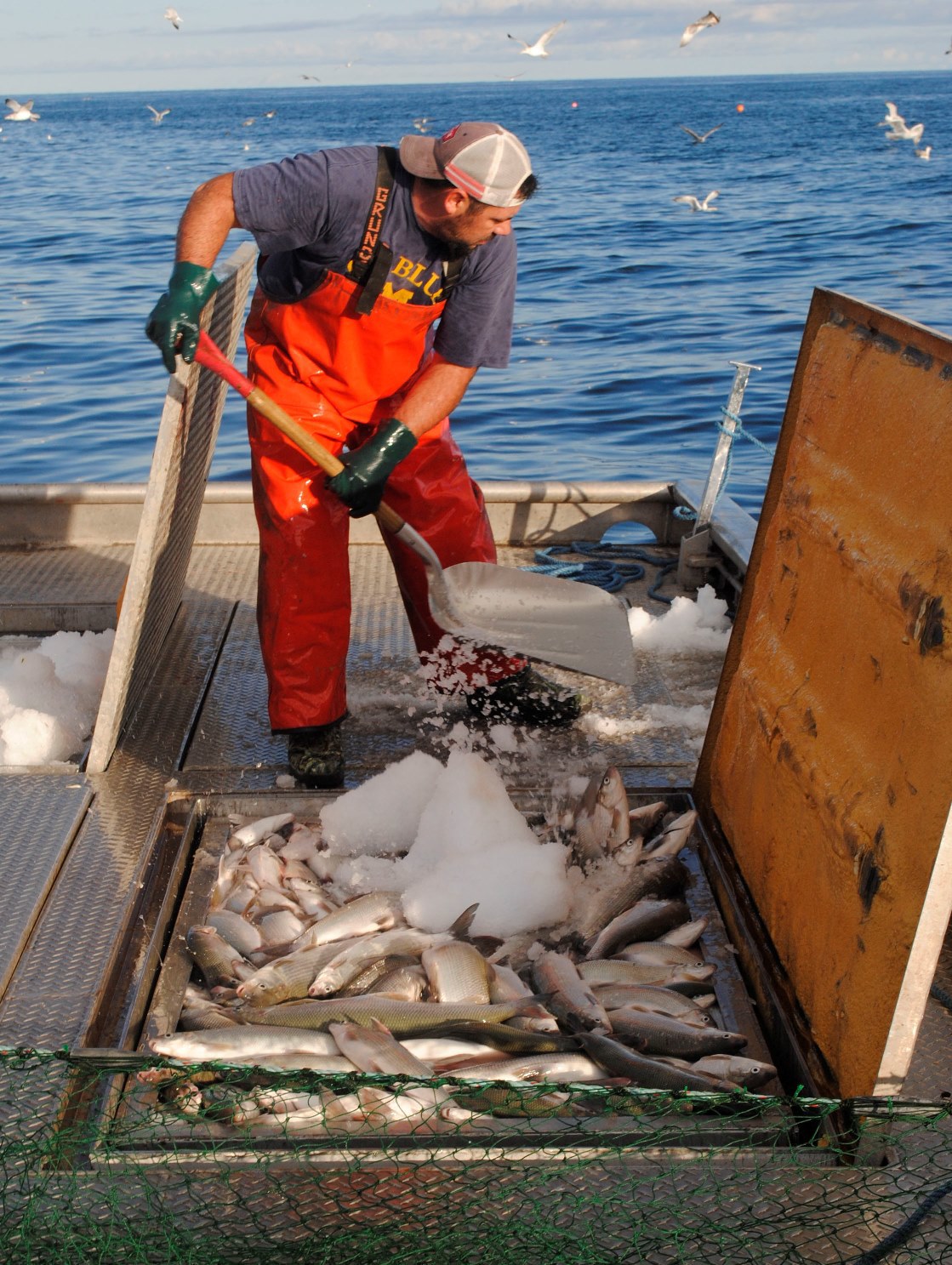Thumb-area Lake Huron commercial fishing experiment may reduce pressure on Saginaw Bay yellow perch
An experimental commercial whitefish venture — operating out of Harbor Beach in Huron County and farther south than similar Lake Huron commercial enterprises — is not only paying dividends for the fisherman involved, it’s designed to benefit Michigan’s sport fishing anglers as well.
The Michigan Department of Natural Resources worked out an agreement with longtime commercial fisherman Dana Serafin, who has fished for perch commercially off Oscoda and in Saginaw Bay for more than two decades.
“This is a three-year evaluation and 2015 was the first year,” said fisheries biologist Tom Goniea, who oversees commercial fishing licensing and regulation for the DNR. “The evaluation will continue in 2016 and 2017, at which point the DNR and the commercial fisher decide together whether this is a viable fishing option going forward.”
 Yellow perch are considered one of the most important and most sought-after species in Lake Huron, especially in Saginaw Bay. Yellow perch are considered one of the most important and most sought-after species in Lake Huron, especially in Saginaw Bay.
However, the bay’s yellow perch population has fallen in recent years as walleye have boomed. With the crash of the Lake Huron alewife population in the mid-2000s, walleye have turned to yellow perch as their main food source.
Todd Grischke, the DNR’s Lake Huron Basin coordinator, said angler hours on Lake Huron over the past 20 years mirror the decline in the abundance of yellow perch.
“While the walleye population explosion is viewed by fisheries managers as a success story, one of the undesirable results is an imbalance in the predator-prey ratio in Saginaw Bay,” Grischke said.
The DNR’s most recent surveys show simultaneously the highest walleye population and the lowest recorded forage base biomass (abundance of food supply) in the past 25 years.
“As a result, yellow perch are now considered the primary forage of most predators in the system including cormorants, northern pike and especially, walleye,” Grischke said.
Perch are reproducing well in Saginaw Bay. However, estimates indicate that more than 99 percent of each year’s production of fish is not surviving past the first year.
 In an effort to revitalize these perch populations, the Michigan Natural Resources Commission responded by increasing the walleye creel limit from five fish to eight per day and decreasing the minimum walleye size limit from 15 inches to 13. In an effort to revitalize these perch populations, the Michigan Natural Resources Commission responded by increasing the walleye creel limit from five fish to eight per day and decreasing the minimum walleye size limit from 15 inches to 13.
At the same time, the commission decreased the daily possession limit for yellow perch from 50 to 25 fish for Saginaw Bay.
In addition, the DNR struck its deal with Serafin.
“This is a piece of an overall management strategy that’s serving two goals,” Grischke said. “One is to reduce commercial fishing effort out of an already over-capitalized fishery in Saginaw Bay. The second goal is to investigate the status of the lake whitefish population in southern Lake Huron.”
Grischke said the DNR’s previous fish-sampling efforts have not included Lake Huron whitefish. That’s why Serafin’s new commercial fishing operation is considered experimental, because until he began netting there this year no one knew what the whitefish population out of Harbor Beach was like.
”This is an opportunity for us to gather information on that population — ages and growth, population size, fish condition — and whether or not it can support a viable fishery,” Grischke said.
Under the pact with the DNR, Serafin agreed to explore the whitefish population in southern Lake Huron, relieving pressure on the Saginaw Bay perch fishery.
He was rewarded with a catch of almost 100,000 pounds of whitefish this season, despite getting started two months later than he would have liked and fishing half the nets he might ordinarily set.
In exchange for the ability to fish out of Harbor Beach, Serafin would permanently give up his multiple Saginaw Bay licenses, and future harvest potential, something the DNR said is significant for Saginaw Bay.
“We’re doing a lot of things in Saginaw Bay to address commercial fishing, walleye and yellow perch,” Grischke said. “Our management objective for Saginaw Bay is multifaceted. We’re dealing with recreational fishing regulations, cormorant control and, now, an experiment to remove commercial fishery effort from the bay.” perch,” Grischke said. “Our management objective for Saginaw Bay is multifaceted. We’re dealing with recreational fishing regulations, cormorant control and, now, an experiment to remove commercial fishery effort from the bay.”
The DNR also plans to stock lake herring.
“We want to try an experimental reintroduction of lake herring to provide both forage and fishing opportunity. We’re doing all of these things collectively with the ultimate goal of improving yellow perch populations and the fishery, Grischke said. “When perch populations are good, people go fishing.”
When Serafin’s whitefish venture was first proposed, the idea immediately drew some negative reaction from sport anglers who were concerned about potential conflicts with the netting operation.
Grischke said he understood the concern, but said the potential for conflict had changed significantly over the years.
“The salmon fishery has collapsed in southern Lake Huron,” Grischke said. “The potential for user conflict has waned.”
Grischke said the DNR and the Lake Huron Citizen Advisory Committee talked extensively about what this evaluation project is and what this isn’t.
“It’s an opportunity for a new commercial venture outside the area that is frequented by recreational anglers,” Grischke said. “We believe both recreational fishing and commercial fishing can co-exist here, just as they do throughout the Great Lakes.”
 Goniea spent a lot of time this summer and fall accompanying Serafin and his crew aboard their 58-foot vessel, observing and recording data. Goniea spent a lot of time this summer and fall accompanying Serafin and his crew aboard their 58-foot vessel, observing and recording data.
“We’re taking a look at potential impacts on nontarget species. We’re watching it pretty closely,” Goniea said. “Whitefish make up 90 to 95 percent of the fish in the nets by number, but you see some drum, walleye and lake trout.”
According to Goniea, Serafin’s operation so far is not having a negative impact on lake trout or walleye in Lake Huron. He was most recently aboard Serafin’s boat for a day in late October.
“They had 206 lake trout in three nets — 202 alive and four dead,” Goniea said. “With a release rate this high of what appear to be very healthy lake trout, that is negligible impact.”
In contrast, most of the walleye captured incidentally in the nets are dead. This is because walleye are not able to regulate their air bladders quickly enough when surfacing from a water depth of 100 feet. However, walleye numbers in the nets have been very low.
“Walleyes are not going to survive coming up from that depth. But for all our monitoring this year, there was never more than eight walleye per net lift,” Goniea said. “This is a very low incidental catch rate when compared to the incidental catch rates of hundreds of walleye per lift on Saginaw Bay.”
Goniea said shifting the fishing pressure from Saginaw Bay perch to Lake Huron whitefish could be a win-win situation for both commercial fishermen and recreational anglers.
“If this experiment is successful, there will be a lot of commercial gear retired from an area that has a lot of it and transferring some of it to an area without any, while simultaneously shifting the commercial harvest from yellow perch to whitefish,” Goniea said. “If this is successful, we’re looking to remove 20 percent of the licenses in Saginaw Bay and 30 percent of the trap nets. That’s huge.”
At this point, no additional commercial fisheries beyond Serafin’s are being considered for transfer out of Saginaw Bay.
Although the DNR or Serafin can back out of the three-year evaluation agreement, Goniea said he sees no reason why that should happen.
Though only one year into the study, the southern Lake Huron whitefish fishery seems robust enough to sustain the commercial activity, by-kill of nontarget species has been very low, and the DNR hasn’t recorded conflict with sport fishing anglers off Harbor Beach.
For more information on commercial fishing in Michigan, visit www.michigan.gov/fishing.
/Note to editors: Contact: Todd Grischke, 517-284-5826 or John Pepin, 906-226-1352. Accompanying photos are available below for download. Suggested captions follow.
Chute: Commercial fishermen sort fish from a trap net, sending whitefish down a chute into a bin.
Whitefish: Lake Huron whitefish, on ice, before going to the market.
Net: Dana Serafin, foreground, and his crew unload lake whitefish from a trap net near Harbor Beach.
Shovel: Crewman Tom Burleson shovels ice into a bin full of whitefish./
The Michigan Department of Natural Resources is committed to the conservation, protection, management, use and enjoyment of the state’s natural and cultural resources for current and future generations. For more information, go to www.michigan.gov/dnr.
|

 Yellow perch are considered one of the most important and most sought-after species in Lake Huron, especially in Saginaw Bay.
Yellow perch are considered one of the most important and most sought-after species in Lake Huron, especially in Saginaw Bay. In an effort to revitalize these perch populations, the Michigan Natural Resources Commission responded by increasing the walleye creel limit from five fish to eight per day and decreasing the minimum walleye size limit from 15 inches to 13.
In an effort to revitalize these perch populations, the Michigan Natural Resources Commission responded by increasing the walleye creel limit from five fish to eight per day and decreasing the minimum walleye size limit from 15 inches to 13. perch,” Grischke said. “Our management objective for Saginaw Bay is multifaceted. We’re dealing with recreational fishing regulations, cormorant control and, now, an experiment to remove commercial fishery effort from the bay.”
perch,” Grischke said. “Our management objective for Saginaw Bay is multifaceted. We’re dealing with recreational fishing regulations, cormorant control and, now, an experiment to remove commercial fishery effort from the bay.” Goniea spent a lot of time this summer and fall accompanying Serafin and his crew aboard their 58-foot vessel, observing and recording data.
Goniea spent a lot of time this summer and fall accompanying Serafin and his crew aboard their 58-foot vessel, observing and recording data.




